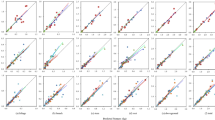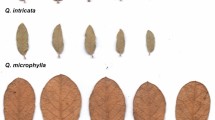Abstract
Resource allocation and the seasonal change of stem length inEuphorbia lasiocaula Boiss. andE. sinanensis (Hurusawa) T. Kurosawa et H. Ohashi were examined in 10 populations on hills in Miyagi Prefecture, northern Japan. Differences were found in the diameter of stem, stem/leaf ratio of dry weight, vegetative dry weight/leaf area, and the beginning, end and duration of stem growth.Euphorbia lasiocaula has a thicker stem, a larger stem/ leaf ratio, a larger vegetative dry weight/leaf area, a later beginning and end of stem growth and a longer period of stem growth thanE. sinanensis. These differences support the relationships among plant height, resource allocation and phenology predicted by the mathematical models of Givnish (1982) and Sakai (1991, 1994). The tall and thick stems ofE. lasiocaula are considered to be favorable for capturing sunlight in grassy places, causing it to allocate much of its resources to the stems. On the other hand,E. sinanensis is considered to be adapted to deciduous forest floors or forest margins because it completes growing before it is shaded by canopy trees or by tall herbs, which is enabled by the larger allocation of resources to the leaves.
Similar content being viewed by others

References
Abrahamson, W. G. andGadgil, M. 1973. Growth form and reproductive effort in goldenrods (Solidago, Compositae). Am. Nat.107: 651–661.
Brouillet, L. andSimon, J.-P. 1979. Resource allocation and phenology of two species ofAster (Asteraceae) and their hybrid. Can. J. Bot.57: 1792–1799.
Crawley, M.J. 1986. Life history and environment.In M. J. Crawley, ed., Plant Ecology, Blackwell Scientific Publications, Oxford. pp. 253–290.
Givnish, T.J. 1982. On the adaptive significance of leaf height in forest herbs. Am. Nat.120: 353–381.
Givnish, T.J. 1986. Biomechanical constraints on crown geometry in forest herbs.In T.J. Givnish, ed., On the Economy of Plant Form and Function. Cambridge University Press, Cambridge. pp. 525–583.
Grime, J.P. 1979. Plant Strategies and Vegetation Processes. John Wiley & Sons, Ltd., Chichester.
Haraguchi, A. 1993. Phenotypic and phenological plasticity of an aquatic macrophyteMenyanthes trifoliata L. J. Plant Res.106: 31–35.
Iwasa, Y., Cohen, D. andLeon, J.A. 1985. Tree height and crown shape, as results of competitive games. J. theor. Biol.112: 279–297.
Kurosawa, T. andOhashi, H. 1994. Morphological, phenological and taxonomical studies onEuphorbia lasiocaula andE. sinanensis (Euphorbiaceae). J. Jpn. Bot.69: 1–13.
Maximowicz, C.J. 1883. Diagnoses plantarum novarum Asiaticarum. V. Bull. Acad. Sci. St. Pétersb.29: 51–227.
Reid, A. 1964. Light intensity and herb growth in white oak forests. Ecology45: 396–398.
Rice, W.R. 1989. Analyzing tables of statistical tests. Evolution43: 223–225.
Sakai, S. 1991. A model analysis for the adaptive architecture of herbsceous plants. J. theor. Biol.148: 535–544.
Sakai, S. 1994. Optimal leaf phenology and photosynthetic capacity of herbs dependent on the genet density of herbs in their habitat. J. theor. Biol.166: 237–244.
Stutzel, H., Charles-Edwards, D.A. andBeech, D.F. 1988. A model of the partitioning of new above-ground dry matter. Ann. Bot.61: 481–487.
Sugawara, K. 1969. Ecological studies in the Botanical Garden of the Tôhoku University. I. Present state of the vegetation. Ecol. Rev.17: 209–216.
Waller, D.M. 1986. The dynamics of growth and form.In M.J. Crawley, ed., Plant Ecology. Blackwell Scientific Publications, Oxford. pp. 291–320.
Webster, G.L. 1967. The genera of Euphorbiaceae in the southeastern United States. J. Arnold Arbor.48: 303–430.
Author information
Authors and Affiliations
Rights and permissions
About this article
Cite this article
Kurosawa, T. Ecological differentiation ofEuphorbia lasiocaula andE. sinanensis (Euphorbiaceae) I plant height, phenology and allocation to stems and leaves. J. Plant Res. 108, 277–281 (1995). https://doi.org/10.1007/BF02344353
Received:
Accepted:
Issue Date:
DOI: https://doi.org/10.1007/BF02344353



